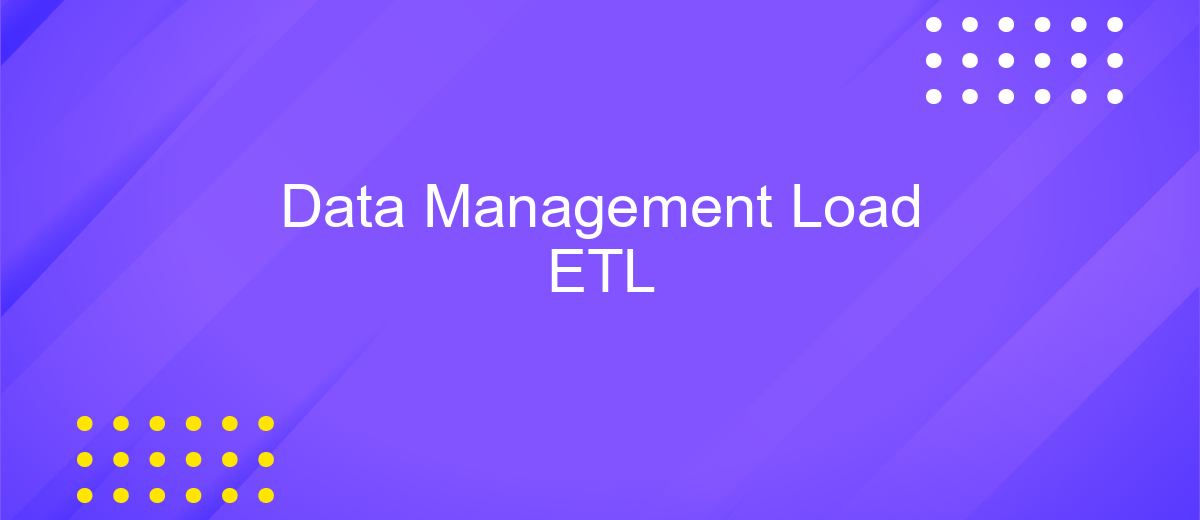Data Management Load ETL
Data Management Load ETL (Extract, Transform, Load) is a crucial process in modern data handling, enabling organizations to efficiently extract data from various sources, transform it into a suitable format, and load it into target systems for analysis. This article explores the fundamentals of ETL, its importance in data management, and best practices for optimizing ETL workflows to ensure data integrity and performance.
Introduction
Data Management Load (ETL) is a crucial process in modern data handling, enabling organizations to efficiently extract, transform, and load data from various sources into a centralized repository. This process ensures data consistency, quality, and accessibility, which are essential for informed decision-making and strategic planning.
- Extraction: Gathering raw data from multiple sources.
- Transformation: Converting data into a suitable format for analysis.
- Loading: Inserting the transformed data into a target database or data warehouse.
Integrating various data sources can be complex, but services like ApiX-Drive simplify this task by providing seamless integration solutions. ApiX-Drive allows businesses to automate data flows between applications, ensuring that data is always up-to-date and readily available for analysis. By leveraging such tools, organizations can enhance their ETL processes, reduce manual effort, and improve overall data management efficiency.
Data Loading Concepts

Data loading is a critical phase in the ETL (Extract, Transform, Load) process, where transformed data is moved from a staging area to a target system, such as a data warehouse or database. This step ensures that data is accurately and efficiently transferred, maintaining data integrity and consistency. Proper data loading techniques can significantly impact the performance and reliability of the entire data management system, making it essential to choose the right methods and tools for the task.
One of the key considerations in data loading is the choice of integration services that facilitate seamless data transfer. Tools like ApiX-Drive can simplify this process by offering automated workflows and real-time data synchronization between various applications and databases. ApiX-Drive's user-friendly interface and robust functionality enable businesses to set up integrations quickly, reducing manual effort and minimizing errors. By leveraging such services, organizations can ensure that their data loading processes are efficient, scalable, and adaptable to changing business needs.
ETL Process Overview

The ETL (Extract, Transform, Load) process is essential for managing data flows within organizations. It involves extracting data from various sources, transforming it into a suitable format, and loading it into a target system. This ensures that data is accurate, consistent, and readily available for analysis and decision-making.
- Extract: Data is collected from multiple sources such as databases, APIs, and flat files. This step ensures that all relevant information is captured.
- Transform: The extracted data undergoes cleaning, normalization, and enrichment. This step may involve filtering, aggregation, and applying business rules to ensure data quality and consistency.
- Load: The transformed data is then loaded into a target system, such as a data warehouse or a data lake, where it can be accessed for reporting and analysis.
Leveraging tools like ApiX-Drive can streamline the ETL process by automating data integrations and transformations. ApiX-Drive offers a user-friendly interface to connect various data sources, apply necessary transformations, and ensure seamless data flow into your target systems. This not only saves time but also enhances data accuracy and reliability.
Data Transformation Techniques

Data transformation is a crucial step in the ETL process, involving the conversion of raw data into a format suitable for analysis. This process ensures that data from various sources can be integrated, cleaned, and made consistent for downstream applications.
There are several techniques used in data transformation, each addressing different aspects of data quality and integration. These techniques help in standardizing data formats, removing duplicates, and enriching data for better insights.
- Data Cleaning: Removing errors and inconsistencies to ensure data quality.
- Data Integration: Combining data from multiple sources into a unified view.
- Data Aggregation: Summarizing detailed data to provide higher-level insights.
- Data Enrichment: Enhancing data with additional information for more comprehensive analysis.
- Data Normalization: Standardizing data formats for consistency and compatibility.
Tools like ApiX-Drive can simplify the integration process by automating data transfers between various applications and databases. This not only saves time but also reduces the risk of errors, ensuring that transformed data is accurate and reliable for decision-making.
- Automate the work of an online store or landing
- Empower through integration
- Don't spend money on programmers and integrators
- Save time by automating routine tasks
Best Practices and Considerations
Effective Data Management Load ETL processes require careful planning and execution to ensure data integrity, efficiency, and scalability. One best practice is to implement robust data validation mechanisms at each stage of the ETL pipeline. This ensures that data is accurate and consistent before it is loaded into the target system. Additionally, optimizing the performance of ETL jobs by scheduling them during off-peak hours and using parallel processing techniques can significantly reduce the time required for data loading.
Another crucial consideration is the integration of various data sources. Utilizing services like ApiX-Drive can simplify the integration process by providing seamless connections between different applications and data sources. This not only saves time but also reduces the complexity associated with manual integration efforts. Furthermore, maintaining detailed documentation and monitoring logs for ETL processes is essential for troubleshooting and continuous improvement. Regularly reviewing and updating ETL workflows ensures that they remain aligned with evolving business requirements and technological advancements.
FAQ
What is ETL in Data Management?
Why is ETL important for businesses?
How often should ETL processes be run?
What challenges can arise during ETL processes?
Can ETL processes be automated?
Time is the most valuable resource in today's business realities. By eliminating the routine from work processes, you will get more opportunities to implement the most daring plans and ideas. Choose – you can continue to waste time, money and nerves on inefficient solutions, or you can use ApiX-Drive, automating work processes and achieving results with minimal investment of money, effort and human resources.


